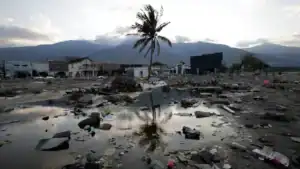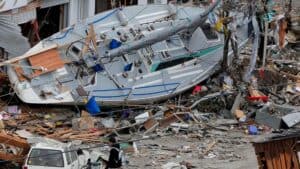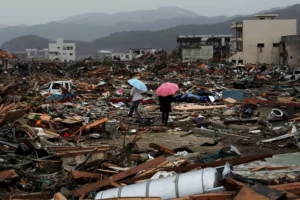✅ Meta Description
Explore the Top 10 Most Powerful Earthquakes in History ever recorded, including Russia’s 2025 8.8 quake, and how it ranks among history’s deadliest seismic events.
📰 Full Article:
Russia’s Massive 8.8-Magnitude Earthquake Among the Strongest Ever Recorded
Date: July 30, 2025
Source: Associated Press | Rewritten by TrendTeller
An 8.8-magnitude earthquake struck off the coast of Russia’s Far East early Wednesday morning, triggering tsunami alerts across the Pacific Rim — from Japan and Alaska to Hawaii and even as far as Central America. The tremor, now confirmed as one of Top 10 Most Powerful Earthquakes in History, caused widespread concern and urgent evacuations in coastal areas as emergency services rushed to assess the damage.
This seismic event has joined Top 10 Most Powerful Earthquakes in History most catastrophic earthquakes. Here’s a comprehensive look at the Top 10 Most Powerful Earthquakes in History ever recorded, how devastating they were, and how Russia’s recent quake compares.

🌍 1. Valdivia Earthquake, Chile (1960) – Magnitude 9.5
Still the most powerful earthquake ever recorded, the Valdivia earthquake struck central Chile on May 22, 1960, with a staggering magnitude of 9.5. The quake and the resulting tsunami led to the deaths of over 1,600 people and displaced more than two million. It caused destruction not only in Chile but also across the Pacific — including Hawaii, Japan, and the Philippines. Entire towns were flattened, and seismic waves circled the globe.
🌊 2. Prince William Sound, Alaska (1964) – Magnitude 9.2
Known as the Great Alaskan Earthquake, this quake hit Alaska on March 27, 1964. It lasted approximately 4.5 minutes and caused massive tsunamis, some waves reaching up to 67 meters high. Over 130 lives were lost, and the quake caused enormous landslides, ruptured highways, and collapsed buildings. The tremor even caused time clocks in Seattle — 1,200 miles away — to stop ticking.
🌐 3. Indian Ocean Earthquake, Sumatra, Indonesia (2004) – Magnitude 9.1
This undersea earthquake occurred on December 26, 2004, off the coast of Sumatra, Indonesia. The 9.1-magnitude quake triggered a deadly tsunami that ravaged parts of Southeast Asia and East Africa. Indonesia bore the brunt of the disaster, with over 167,000 deaths reported. Overall, more than 230,000 people died in 14 countries, making it one of the deadliest natural disasters in modern history.

☢️ 4. Tohoku Earthquake, Japan (2011) – Magnitude 9.1
On March 11, 2011, a 9.1-magnitude earthquake struck off the northeast coast of Japan, creating a powerful tsunami that devastated cities and villages along the coastline. It also triggered the Fukushima nuclear disaster, where three nuclear reactors experienced meltdowns. More than 18,000 people were killed, and thousands more remain missing. The cost of the disaster exceeded $235 billion — the most expensive natural disaster ever recorded.
❄️ 5. Kamchatka Earthquake, Russia (1952) – Magnitude 9.0
On November 4, 1952, a massive 9.0-magnitude quake struck the Kamchatka Peninsula in eastern Russia. Although the tsunami generated by the quake hit Hawaii with 30-foot (9.1-meter) waves, no deaths were officially recorded, thanks in part to the region’s sparse population. However, it caused widespread structural damage and raised global awareness about Pacific-wide tsunami threats.
🇨🇱 6. Maule Earthquake, Chile (2010) – Magnitude 8.8
Chile again faced disaster on February 27, 2010, when an 8.8-magnitude earthquake rocked the Biobío region. The quake lasted approximately 90 seconds and was felt across the country, including the capital, Santiago. More than 500 people were killed, and massive damage affected highways, bridges, and homes. A tsunami followed, causing further destruction along the coastline.
🇪🇨 7. Esmeraldas Earthquake, Ecuador (1906) – Magnitude 8.8
One of the earliest major quakes in the 20th century, the 1906 earthquake off the coast of Ecuador and Colombia had a magnitude of 8.8. The resulting tsunami affected areas as far as San Francisco and Japan. Historical records estimate between 500 and 1,500 deaths. Despite limited technology at the time, this quake remains one of the most impactful in Latin American history.
🏔️ 8. Rat Islands Earthquake, Alaska (1965) – Magnitude 8.7
On February 4, 1965, the Rat Islands in Alaska were rocked by an 8.7-magnitude quake. The remote location limited the damage and casualties, but it did trigger a tsunami with waves reaching 11 meters (35 feet). Structural damage occurred, including deep cracks in roads and buildings. The event served as a stark reminder of the seismic volatility of the Pacific Ring of Fire.
🧱 9. Assam-Tibet Earthquake (1950) – Magnitude 8.6
One of the deadliest earthquakes to hit the Himalayan region, the 1950 Assam-Tibet quake killed at least 780 people. Villages were flattened, and massive landslides blocked rivers, leading to flooding when the waters eventually broke through. It remains the most powerful earthquake ever recorded on land.

🇮🇩 10. Northern Sumatra, Indonesia (2012) – Magnitude 8.6
On April 11, 2012, an 8.6-magnitude earthquake occurred off the coast of northern Sumatra. Fortunately, the quake caused relatively minor damage and few injuries due to its deep location and quick alerts. However, scientists observed that the quake increased pressure along regional faults, adding concern about future events in an already volatile area.
🌐 Where Does Russia’s 2025 Earthquake Rank?
The 2025 Russia earthquake, measuring 8.8 in magnitude, now stands among the Top 10 Most Powerful Earthquakes in History ever recorded in modern history. Although the full extent of the damage is still being assessed, tsunami waves have already been reported in Japan, Alaska, and several Pacific islands.
Emergency warnings were issued as far as Hawaii, Central America, and New Zealand. Authorities have urged coastal residents to move to higher ground and remain alert for aftershocks and secondary waves.

📌 What Makes a Quake Dangerous?
Magnitude alone doesn’t always indicate the level of devastation. Other factors include:
-
Depth of the quake
-
Location (land vs sea)
-
Population density of the area
-
Tsunami generation
-
Response time and infrastructure
The Russia 2025 quake, while massive, occurred offshore, which may help reduce casualties — unlike urban quakes that strike densely populated cities.
🧠 Conclusion
The Earth is always shifting — sometimes violently. From Chile to Alaska, and now Russia, the history of seismic activity reveals just how powerful and unpredictable our planet can be. While science has come a long way in predicting and preparing for quakes, nature often moves faster than we can.
The 2025 Russia earthquake is a stark reminder of this reality, ranking as one of Top 10 Most Powerful Earthquakes in History temblors in modern times and reigniting global conversations about disaster readiness and climate resilience.




